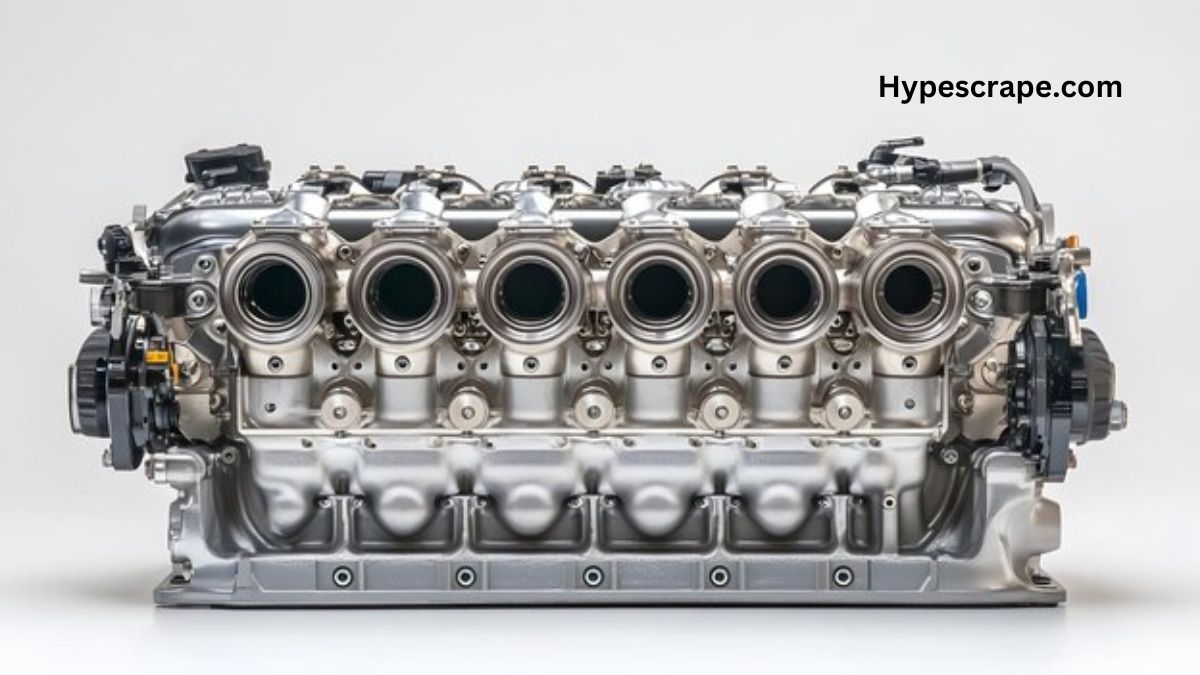AUTOMOTIVE
Cracking the Code of sb 350 aluminum engine head number 643 information

Revving up the car enthusiast’s world, the sb 350 aluminum engine head number 643 information is a topic that ignites curiosity and innovation. For those passionate about automotive performance, understanding this component can make all the difference in optimizing your vehicle’s prowess. Whether you’re a seasoned mechanic or an amateur gearhead, this post will guide you through everything you need to know about this powerhouse part, unraveling its intricacies and potential.
The Legend of the SB 350 Engine
The SB 350 engine is a staple in the automotive industry. Known for its durability and power, it has powered countless vehicles, earning a place in the hearts of enthusiasts. This section dives into the rich history of the SB 350, exploring its evolution and significance in the realm of performance engines.
For years, the SB 350 has been celebrated for its dependable nature and adaptability. Originally introduced by Chevrolet in the late 1960s, this small block engine quickly became popular due to its power-to-weight ratio. Its versatility meant it could be tuned for various performance levels, making it a favorite among car builders and racers.
Many automotive enthusiasts consider the SB 350 a classic. Not only has it powered iconic cars like the Camaro and Corvette, but it continues to be a sought-after engine for restorations and custom builds. Its legacy is undeniable, with millions of units produced and still running strong today.
Why Aluminum Heads Matter
Aluminum heads are revered in the racing world. They offer multiple benefits over their cast-iron counterparts, crucially impacting performance. Here, we explore the advantages of opting for aluminum, from weight savings to improved heat dissipation.
Weight is a critical factor when it comes to performance. Aluminum is significantly lighter than iron, which translates to better acceleration and handling. By reducing the overall weight of the engine, aluminum heads contribute to a more agile vehicle, a factor often sought by racers and performance enthusiasts.
Another benefit is aluminum’s superior thermal conductivity. This material dissipates heat faster than iron, which helps maintain optimal engine temperatures. Keeping the engine cooler is essential for preserving performance and reliability, particularly during high-stress conditions like racing.
Furthermore, aluminum heads offer tuning flexibility. They are easier to machine, allowing for custom modifications without the risk of cracking, a common issue with iron heads. This adaptability is vital for those looking to extract every ounce of power from their engines.
The Secret Behind Number 643
The engine head number 643 holds particular allure for car fanatics. This section deciphers what makes this head unique, examining its design features and specifications that contribute to its popularity among enthusiasts.
The number 643 isn’t just a serial identifier; it signifies a series of design improvements that enhance performance. One of the standout features of this head is its optimized combustion chamber design, which promotes efficient air-fuel mixture burning, leading to increased horsepower and torque.
Port design is another area where the 643 excels. These heads feature larger and smoother intake and exhaust ports, maximizing airflow. Enhanced airflow results in better engine breathing, which directly impacts power output and efficiency.
Additionally, the 643 head is known for its high-performance valve train components. With robust springs and valves designed to handle higher RPMs, this head supports aggressive cam profiles and helps achieve the desired engine output in competitive settings.
Installation Insights and Tips
Installing the sb 350 aluminum engine head number 643 information requires precision and care. This section provides a walkthrough of the installation process, offering practical tips to ensure a successful setup and avoid common pitfalls.
First and foremost, preparation is key. Before starting the installation, ensure that the engine block surfaces are clean and free of debris. Any residue can compromise the seal between the head gasket and the block, leading to leaks and performance loss.
Torque specifications are crucial during installation. Always follow the manufacturer’s recommended torque sequence and specifications to avoid warping the heads. Gradual and even tightening of the bolts ensures a proper seal and longevity of the head gasket.
It is equally important to verify clearances. Check for adequate piston-to-valve clearance, especially if using high-lift camshafts. Overlooking this step can result in catastrophic engine damage. Taking the extra time to measure and adjust clearances as needed is well worth the effort.
Performance Enhancements with 643
The 643 head is renowned for its performance potential. Here, we explore how this component can elevate your engine’s capabilities, discussing various upgrades and enhancements that unlock its full power.
Pairing the 643 head with a high-performance camshaft is a popular modification. This combination takes advantage of the head’s improved airflow and valve train capability, translating to significant gains in horsepower and torque.
Intake manifold selection is another critical factor. A well-matched intake manifold complements the head’s flow characteristics, optimizing air and fuel delivery. This synergy is essential for achieving peak engine performance.
Additionally, upgrading to a performance exhaust system can further enhance the benefits of the 643 head. By reducing backpressure and improving exhaust flow, you unlock additional power and efficiency. The right exhaust system can make a noticeable difference in how the engine responds and sounds.
Common Issues and Troubleshooting
Even the best components can encounter issues. This section addresses common problems associated with aluminum heads and offers troubleshooting tips to keep your engine running smoothly.
One common issue is head gasket failure. Aluminum heads expand and contract with temperature changes, which can stress the gasket. Regularly inspecting for signs of leaks and addressing them promptly can prevent future failures.
Another potential problem is valve train noise. This can occur if the valvetrain components are not properly adjusted or if wear occurs over time. Routine checks and adjustments of rocker arm lash and lifter preload can mitigate these issues.
Overheating can also be a concern, particularly in high-performance applications. Ensuring adequate cooling system capacity and using high-quality coolant can help maintain optimal engine temperatures and prevent overheating.
Customization and Tuning for Optimal Performance
Customization allows you to tailor the 643 head to your exact needs. This section explores various tuning options and customizations that can elevate performance and reliability.
Camshaft selection plays a pivotal role in customization. Matching the camshaft profile to your head’s specifications ensures that you tap into its full potential. Consider factors like lift, duration, and lobe separation angle when choosing a camshaft.
Cylinder head porting is another avenue for customization. Porting involves reshaping the intake and exhaust ports to improve airflow. While it’s a more advanced modification, the gains in efficiency and power can be substantial.
Tuning the engine management system is the final piece of the puzzle. Adjusting parameters like ignition timing and fuel delivery to match your head and camshaft setup maximizes performance gains. A professional dyno tune can provide precise adjustments for optimal results.
Maintaining Your Aluminum Heads
Proper maintenance is essential for the longevity of your aluminum heads. This section provides guidelines for keeping your engine in top condition, ensuring reliable performance over the long haul.
Regular oil changes are crucial. Engine oil lubricates and cools components, reducing wear and preventing overheating. Use high-quality oil that meets the manufacturer’s specifications for best results.
Inspecting the cooling system should also be part of your routine maintenance. Checking for leaks, proper coolant level, and radiator function ensures that your engine remains within safe operating temperatures.
Lastly, periodically check the torque on head bolts, especially after initial installation and break-in. Retorquing the bolts ensures that they remain tight, preserving the integrity of the head gasket seal.
Cost Considerations and Budgeting
Installing high-performance components involves cost considerations. This section breaks down the expenses involved with the 643 head and provides tips for budgeting your build.
The initial cost of the 643 head is a significant investment. However, it’s essential to factor in the potential gains in performance and reliability. Consider this an investment in your vehicle’s future capabilities and value.
Additional costs may include complementary components. Items such as upgraded camshafts, intake manifolds, and valve train parts should be considered when budgeting for your build. Each component contributes to the overall performance package.
Labor costs can also add up, particularly if you’re not performing the installation yourself. Budgeting for professional installation can provide peace of mind and ensure that the job is done correctly.
Conclusion
The sb 350 aluminum engine head number 643 information isn’t just a component; it’s a gateway to unlocking the true potential of your vehicle’s engine. With its lightweight construction, superior thermal properties, and enhanced airflow design, this engine head transforms automotive performance. By understanding its features, installation process, and potential for customization, you pave the way for a powerful and reliable engine setup.
For those ready to take their engine to the next level, the 643 head offers unparalleled performance and tuning possibilities. With proper maintenance and thoughtful modifications, this head can deliver the driving experience you’ve always dreamed of. Whether you’re building a race car or enhancing your daily driver, the 643 holds the key to engine excellence.
AUTOMOTIVE
The Unlikely Journey of F1 Ferraris During WWII in New Jersey

In an unexpected twist of fate, some of the earliest F1 Ferraris cars found themselves in an unplanned sojourn on American soil during World War II. While these racing legends are now synonymous with speed and luxury, their wartime narrative is a fascinating detour that adds a layer of intrigue to their illustrious history. This article takes you on a ride through time, exploring how these iconic vehicles ended up in New Jersey, the impact of their presence, and the legacy they left behind. Whether you’re a history buff, car enthusiast, or just someone who loves a good story, you’ll find plenty to enjoy as we unravel this fascinating chapter.
The Origins of Ferrari’s Racing Heritage
Ferrari’s roots in the world of racing trace back to the early 20th century. Founded by Enzo Ferrari in 1939 as Auto Avio Costruzioni, the company was initially part of Alfa Romeo. Enzo’s dream was to build a car with unprecedented speed, and by 1947, the first official Ferrari-badged car, the 125 S, hit the racing circuits. But what many don’t know is that before these legendary machines became icons of Formula 1 racing, their prototypes were already making waves.
During the early 1940s, Ferrari was still in its infancy. The company’s focus was on building cars that could dominate the racing scene. By the time World War II erupted, plans were interrupted, leading to unforeseen consequences. With the world in turmoil, the production and testing of these race cars were often dictated by the ongoing global conflict, setting the stage for their unexpected detour to America.
These early models were a testament to Ferrari’s commitment to performance and innovation. Their cutting-edge engineering and sleek Italian design marked them as vehicles of distinction, even in their nascent stages. This passion for excellence would eventually lay the foundation for Ferrari’s legendary status in the automotive world.
World War II’s Impact on the Racing World
The onset of World War II brought with it significant disruption to the world of motorsport. Racing events across Europe were canceled, and many manufacturers shifted their focus to supporting wartime efforts. Factories that once buzzed with the sounds of high-performance engines now produced military equipment and vehicles.
This shift had a profound impact on car manufacturers like Ferrari. With resources diverted towards the war, the development of racing cars slowed significantly. Enzo Ferrari, however, remained undeterred, driven by his vision of creating the fastest cars in the world. Despite the challenges, he continued to work on refining his designs, albeit at a slower pace.
The war also changed the landscape of international transport. With ports under threat and trade routes disrupted, shipping goods across continents became a precarious endeavor. This environment set the stage for the unexpected diversion of some early F1 Ferraris to the shores of New Jersey, a consequence of logistical challenges and the global state of affairs.
The Unexpected Detour to New Jersey
The tale of how these early F1 Ferraris ended up in New Jersey is shrouded in both mystery and serendipity. During World War II, maritime transport was fraught with danger due to the presence of enemy submarines and mines. Ships bound for Europe often had to alter their routes to avoid conflict zones, leading to unexpected detours.
Amidst this chaotic backdrop, a shipment containing prototype Ferrari race cars found itself rerouted to the United States. Initially intended for a different destination, these cars were docked in New Jersey for safekeeping, awaiting a safer passage to Europe. This unplanned stopover turned into a longer-than-expected stay as the war continued to ravage the continent.
While in New Jersey, these cars were stored and maintained by local enthusiasts who recognized their potential. Although unable to race, the Ferraris became a subject of intrigue for those who had the chance to see them firsthand. Their presence in the US was a rare glimpse into the future of European motorsport, offering a taste of what was to come once peace returned.
The Fascination with European Engineering
The American public’s fascination with these F1 Ferraris was immediate and palpable. At a time when most of the world was consumed by conflict, the allure of European craftsmanship, embodied by the sleek lines and powerful engines of these race cars, was undeniable.
Automobile enthusiasts and mechanics alike were drawn to the Ferraris’ advanced engineering. These cars featured technological innovations that were ahead of their time, sparking curiosity and admiration among those who had the opportunity to witness them up close. Their presence offered a unique learning opportunity, allowing American mechanics to study European design principles and engineering practices.
This interaction had a lasting impact on the American automotive scene. It introduced new ideas and techniques that would later influence domestic car production. The F1 Ferraris’ time in New Jersey, though temporary, planted seeds of innovation that would yield fruit in the years to come as the world transitioned from war to peace.
The Role of Automotive Enthusiasts
During their stay in New Jersey, the Ferraris were not left to gather dust. A group of local automotive enthusiasts took an active interest in maintaining these exotic machines. Their efforts ensured that the cars remained in peak condition, preserving their mechanical integrity despite their temporary displacement.
These enthusiasts played a crucial role in keeping the spirit of racing alive during the war. They organized informal gatherings where the Ferraris could be admired and appreciated, fostering a sense of community among car lovers. These events provided a welcome distraction from the hardships of wartime, offering a glimpse of hope and excitement for the future.
The dedication of these individuals ensured that the F1 Ferraris remained ready for action, even if their return to the racetrack was delayed. Their stewardship of these cars demonstrated the enduring passion for motorsport, a passion that transcended borders and circumstances.
The Return to Europe
With the end of World War II in sight, plans were set in motion to return the Ferraris to Europe. Peace meant that the racing world could once again come alive, and these cars were eager to join the fray. The logistical hurdles that had once kept them on American soil were gradually resolved, paving the way for their journey back across the Atlantic.
Enzo Ferrari’s vision for his cars was finally becoming a reality. The prototypes were returned to Italy, where they were further developed and refined. These early models served as the foundation for what would become a dominant force in Formula 1 racing, cementing Ferrari’s status as a premier racing brand.
Their time in New Jersey added an unexpected chapter to their story, one that highlighted the resilience and adaptability of both the cars and the people who cared for them. The F1 Ferraris’ return to Europe marked the beginning of a new era, one in which they would go on to achieve legendary status on the racetrack.
Legacy and Lessons Learned
The legacy of the Ferraris’ wartime detour to New Jersey is multifaceted. On the surface, it is a story of survival and resilience, showcasing how these iconic vehicles weathered the storm of war. But beyond that, it is also a tale of cultural exchange and collaboration, highlighting the mutual respect between American and European automotive communities.
The experience underscored the importance of adaptability and innovation. Faced with unprecedented challenges, those involved with the Ferraris found creative solutions to ensure their preservation and eventual success. This mindset of perseverance and ingenuity is a hallmark of the automotive industry, driving progress even in the face of adversity.
Today, the story of the Ferraris in New Jersey serves as a reminder of the interconnectedness of the global automotive community. It underscores the value of sharing knowledge and expertise, fostering a spirit of cooperation that continues to drive the industry forward.
The Impact on Ferrari’s Future
The Ferraris’ unexpected sojourn in New Jersey had a lasting impact on the brand’s trajectory. While the cars themselves eventually returned to Europe, the interactions and experiences gained during their time in America left an indelible mark on Ferrari’s development.
Exposure to American automotive practices and innovations provided valuable insights that influenced Ferrari’s approach to engineering and design. The brand’s ability to incorporate diverse perspectives contributed to the refinement of their vehicles, enhancing their performance and appeal on the global stage.
This period also strengthened Ferrari’s reputation as a symbol of excellence and adaptability. The challenges faced during World War II, and the subsequent success of the brand, solidified its status as a leader in the automotive world, a legacy that continues to this day.
Conclusion
The story of the F1 Ferraris that found themselves temporarily stranded in New Jersey during World War II is a testament to the resilience and adaptability of both the vehicles and the people who cared for them. It highlights the strength of international collaboration and the enduring passion for motorsport that transcends borders.
For automotive enthusiasts and history buffs alike, this chapter offers a fascinating glimpse into a lesser-known aspect of Ferrari’s storied past. It serves as a reminder that even in the face of adversity, innovation and determination can lead to remarkable achievements.
As the legacy of these iconic cars continues to unfold, their wartime detour remains a captivating tale of the power of perseverance and the enduring spirit of automotive excellence. Whether you’re a seasoned racing fan or a curious newcomer, this story offers valuable lessons and inspiration for all who appreciate the art of the automobile.
-

 BLOG1 year ago
BLOG1 year agoEscape to Tranquility Experience Grange Bardage Percheronne in Normandy
-

 LIFESTYLE1 year ago
LIFESTYLE1 year agoAir Jordan 1 Retro High Off-White University Blue
-

 SOCIAL MEDIA1 year ago
SOCIAL MEDIA1 year agoDecoding the Drive Social Media Pyramid Scheme Mystery
-

 LIFESTYLE1 year ago
LIFESTYLE1 year agoAir Jordan 4 Retro Metallic Purple
-

 BLOG7 months ago
BLOG7 months agoDecoding 540-315-8592: From Numbers to Messages
-

 HOW-TO GUIDES1 year ago
HOW-TO GUIDES1 year agoShop Smart and Save with Goldengatemax.shop Online Guide
-

 BUSINESS1 year ago
BUSINESS1 year agoDemystifying 315-442-5267 Common Myths and Facts Revealed
-

 LIFESTYLE1 year ago
LIFESTYLE1 year agoAir Force 1 Shadow Pistachio Frost
